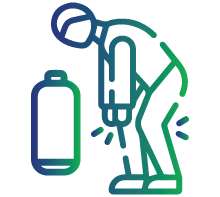
Serum Folate/Folic Acid Test
Serum Folate/Folic Acid
Folate is a naturally occurring vitamin B9 found in many foods and is water-soluble in nature. Folate is required for the growth, development, and proper functioning of red blood cells (RBCs) and nerve tissues. Vitamin B9 works closely with vitamin B12 or cobalamin to help in the formation of more RBCs (erythropoiesis) and also lets iron perform its function well in the body.
A serum folate/folic acid test is done to check the levels of folate in your blood (serum folate) and red blood cells (RBC folate).
Serum Folate/Folic acid test is also known as Folate acid test, Vitamin B9 test, Folacin.
Folate/Folic acid aids in the formation of DNA and RNA, and plays a significant role in the metabolism of proteins. It has a role in the breakdown of homocysteine (an amino acid) that harms the body if present in high amounts. Folic acid also promotes the growth of healthy RBCs, and plays a crucial role during rapid growth, especially in pregnancy and fetal development
Symptoms of Folate Deficiency

Extreme tiredness (fatigue)

Lack of energy

Sore and red tongue

Mouth ulcers

Vision problems

Psychological problems (e.g. mild depression and anxiety)
Who should get tested?
You should get tested for serum folate:

If you suffer from pernicious anemia, in which the immune cells attack healthy cells in the stomach and prevent folate absorption

Lack of folate vitamin in your diet, leading to folate deficiency

Use of certain medications such as anticonvulsants and proton pump inhibitors (PPIs) that affect vitamin uptake by the body
Test preparation:
A blood sample is taken for serum folate/folic acid test. For this reason, you might be asked to fast (no food or drink) for 6 to 8 hours before the sample is collected
Interpretation of results
|
Result in ng/mL |
Interpretation of values |
|
3.1-17.5 |
Normal |
|
2.2-3.0 |
Borderline deficient |
|
< 2.2 |
Deficient |
|
> 17.5 |
Excessive |
FAQs
What are some of the food rich in folate/folic acid?
Some of the folate/folic acid rich foods include legumes, eggs, green leafy vegetables, beets, citrus fruits, nuts and seeds, broccoli, and beef liver
How much dietary folate equivalent (DFE) is recommended for pregnant women?
It is recommended that pregnant women or those planning to conceive take at least 600 micrograms (mcg) of folate/folic acid on a daily basis. However, those with a history of neural tube defects in earlier pregnancies should consult their health care provider
What does a lower-than-normal folic acid level indicate?
A folic acid test result that shows a lower-than-normal level indicates the following:
· Poor diet and malnutrition
· Malabsorption syndrome
· Anemia that is caused as a result of folate deficiency
· Pernicious anemia
What are some of the risks associated with folate/folic acid test?
Other than slight pain and discomfort while drawing out the blood sample with a needle, some of the other associated risk factors are infections, fainting or lightheadedness, excessive bleeding, and hematoma (blood accumulating below the skin’s surface).
Why is it important to address low levels of folate/folic acid in the body?
Low folate/folic acid levels can stop the body from producing healthy and adequate numbers of red blood cells, leading to anemia. It can also cause nerve damage

